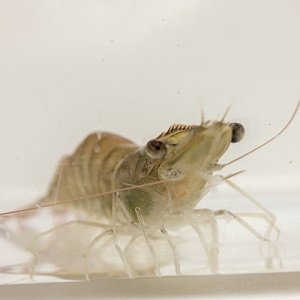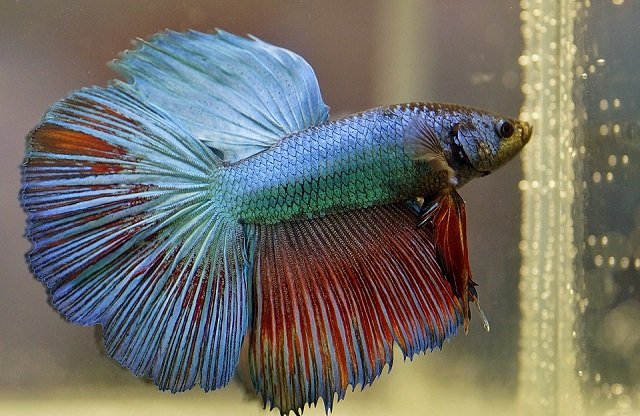
One of the most concerning bacterial pathogens in the global shrimp industry is Vibrio parahaemolyticus, the causative agent of vibriosis, a disease that can lead to high mortalities and significant economic losses on shrimp farms.
A recent study conducted in Egypt by researchers from the Agriculture Research Center (ARC) and Arish University has focused on how water salinity, a fundamental environmental parameter, can modulate the vulnerability of shrimp to V. parahaemolyticus infection, as well as influence their growth and antioxidant defenses. Understanding this relationship is crucial for optimizing management strategies in aquaculture and moving towards a more resilient industry.
The problem: mortalities on farms and the search for answers
The study originated from a real-world situation: two shrimp farms in northern Egypt experiencing high mortality rates. These farms used water with markedly different salinities (4.28 g/L and 28.5 g/L).
The scientists’ first step was to identify the culprit. Bacteriological analyses of moribund shrimp from these farms revealed the presence of three strains of Vibrio parahaemolyticus, designated VHLA1, VHLA2, and VHLA3. Identification was confirmed by detecting key genes associated with this bacterium’s virulence: the integral membrane protein gene (toxR) and the hemolysin genes (tdh and trh). Interestingly, not all strains were identical: the VHLA3 strain possessed all three virulence genes, while VHLA1 and VHLA2 lacked the tdh gene.
A relevant finding for health management is that these strains proved to be multidrug-resistant to several antibiotics, although they were sensitive to ciprofloxacin and florfenicol. This underscores the importance of responsible antibiotic use and the search for preventive strategies.
Simulating farming conditions to understand the effect of salinity
To thoroughly investigate how salinity influenced infection, the researchers designed a controlled experiment. They took 180 healthy L. vannamei shrimp, with an average initial weight of 5.3 grams, and distributed them into three groups, each subjected to a different salinity level for 8 weeks:
- Low salinity: 7 g/L
- Medium salinity (control, similar to seawater): 35 g/L
- High salinity: 50 g/L
These salinities were chosen because they represent ranges that whiteleg shrimp can tolerate and that are found in different farming environments.
Following this acclimatization and growth period, the shrimp from each salinity group were challenged with a median lethal dose (LD50) of the three isolated V. parahaemolyticus strains (VHLA1, VHLA2, and VHLA3). The previously determined LD50 values for these strains were 3.78×105 CFU/mL for VHLA1, 1.99×105 CFU/mL for VHLA2, and 1.95×105 CFU/mL for VHLA3. The scientists evaluated the mortality rate and the bacterial re-isolation rate in the dead shrimp. Additionally, some groups received florfenicol treatment to observe its effectiveness under different salinities.
Stay Always Informed
Join our communities to instantly receive the most important news, reports, and analysis from the aquaculture industry.
Salinity as a double-edged sword
The study’s findings are revealing and offer valuable information for producers.
Mortality and response to antibiotic treatment:
- High salinity (50 g/L): Shrimp kept at this salinity and experimentally infected with strains VHLA1, VHLA2, and VHLA3 showed the highest mortality rates (60%, 80%, and 80%, respectively) compared to shrimp at salinities of 7 and 35 g/L.
- Extreme salinities (7 g/L and 50 g/L): In general, shrimp reared at salinity extremes (low, 7 g/L, and high, 50 g/L) exhibited higher mortality and a greater bacterial re-isolation rate, suggesting that these extreme conditions can stress the animals and make them more susceptible.
- Effectiveness of florfenicol: Florfenicol treatment successfully reduced mortality to ranges between 10-20% in all salinity groups. However, its ability to reduce bacterial presence (re-isolation) varied: it was less effective at 7 g/L (20% reduction in re-isolation) and at 50 g/L (no reduction in re-isolation, being 100% even with treatment for some strains) compared to the medium salinity of 35 g/L (30-40% reduction). This indicates that salinity affects not only the shrimp but also the efficacy of treatments.
Growth performance:
- High salinity (50 g/L): Surprisingly, shrimp reared at the highest salinity (50 g/L) showed significantly higher final weight (15.6 g) and specific growth rate (1.54%/day), along with a lower feed conversion ratio (FCR), compared to the low and medium salinity groups. This might seem contradictory to the higher mortality upon infection.
- Survival: Despite good growth, the overall survival rate during the 8 weeks of cultivation (before the bacterial challenge) was lower in the high salinity group (77.33%) compared to the low salinity (98%) and medium salinity (88.67%) groups. The 7 g/L group had the best overall survival.
Antioxidant and stress response: The study also analyzed the expression of genes related to antioxidant response and stress in the shrimp’s hepatopancreas, a vital organ for metabolism and immunity.
- CAT and SOD: The expression of the antioxidant enzyme genes catalase (CAT) and superoxide dismutase (SOD) was significantly higher in shrimp maintained at 50 g/L compared to lower salinities. This suggests that shrimp in high salinity were experiencing greater oxidative stress and activating their defenses.
- Hsp70: The expression of the heat shock protein 70 gene (Hsp70), a known indicator of cellular stress, was significantly higher at 50 g/L, followed by 7 g/L, and then 35 g/L. This confirms that both high and low salinity can be stressful conditions for shrimp.
Implications of the results for the shrimp industry
This study highlights the complex interaction between shrimp, the pathogen V. parahaemolyticus, and a critical environmental factor like salinity. It is clear that V. parahaemolyticus was the causative agent of the observed mortalities, with different virulence patterns among the strains.
Water salinity emerges as a determining control factor for both the shrimp’s antioxidant status and its susceptibility to V. parahaemolyticus infection. The results suggest that extreme salinities, both very low (7 g/L) and very high (50 g/L), can compromise shrimp health, leading to higher mortality and greater bacterial persistence following an infectious challenge. Although shrimp at 50 g/L showed superior individual growth, this was accompanied by lower overall survival and greater vulnerability to disease, likely due to physiological stress evidenced by the increased expression of antioxidant and Hsp70 genes.
The reduced efficacy of florfenicol in eliminating the bacteria at extreme salinities is a cause for concern. It could indicate that the altered physiological state of shrimp under saline stress interferes with the antibiotic’s action or that the bacteria themselves respond differently to treatment under these conditions.
Previous research had already indicated that changes in salinity can alter the shrimp’s intestinal microbiota and make them more vulnerable to diseases. Other studies have also documented how stress from low or high salinity can affect the immune response and susceptibility to pathogens. For example, it has been observed that low salinity stress can alter the expression of virulence genes in V. parahaemolyticus.
Conclusions and recommendations for the sector
The main conclusions and recommendations arising are:
- Avoid extreme salinities: For L. vannamei farming, both very low (like 7 g/L) and very high (like 50 g/L) salinities should be avoided as much as possible, as they can increase mortality and bacterial load in the face of V. parahaemolyticus infections.
- Optimal salinity management: Although shrimp can grow well individually at 50 g/L, a salinity of 35 g/L (or close to standard seawater) appears to offer a better balance between growth, overall survival, and disease resistance, in addition to greater effectiveness of treatments like florfenicol.
- Prudent use of antibiotics: While florfenicol proved effective in reducing mortality, the observed resistance to other antibiotics and the lower efficacy in eradicating bacteria at extreme salinities highlight the need to implement good management practices, biosecurity, and, when necessary, base treatments on antibiograms.
- Monitoring and prevention: It is essential to monitor water quality, including salinity, and be alert to signs of disease to act quickly.
This study adds another piece to the complex puzzle of health management in shrimp aquaculture. By better understanding how environmental factors like salinity influence animal health, producers can make more informed decisions to prevent diseases and ensure the sustainability of their operations.
Contact
Lamiaa A. Okasha
Bacteriology Unit, Animal Health Research Institute AHRI, Agriculture Research Center ARC
Kafrelsheikh, 12619, Egypt
Email: lamiaa.okasha3525@gmail.com
Ahmed H. Sherif
Fish Diseases Department, Animal Health Research Institute AHRI, Agriculture Research Center ARC
Kafrelsheikh, 12619, Egypt
Email: ahsherif77@yahoo.com
Reference (open access)
Okasha, L.A., Farag, E.A.H., Sayed-ElAhl, R.M.H. et al. Salinity-dependent vulnerability of whiteleg shrimp (Litopenaeus vannamei) to Vibrio parahaemolyticus: growth performance and antioxidant response. Aquacult Int 33, 347 (2025). https://doi.org/10.1007/s10499-025-02033-5
Editor at the digital magazine AquaHoy. He holds a degree in Aquaculture Biology from the National University of Santa (UNS) and a Master’s degree in Science and Innovation Management from the Polytechnic University of Valencia, with postgraduate diplomas in Business Innovation and Innovation Management. He possesses extensive experience in the aquaculture and fisheries sector, having led the Fisheries Innovation Unit of the National Program for Innovation in Fisheries and Aquaculture (PNIPA). He has served as a senior consultant in technology watch, an innovation project formulator and advisor, and a lecturer at UNS. He is a member of the Peruvian College of Biologists and was recognized by the World Aquaculture Society (WAS) in 2016 for his contribution to aquaculture.




